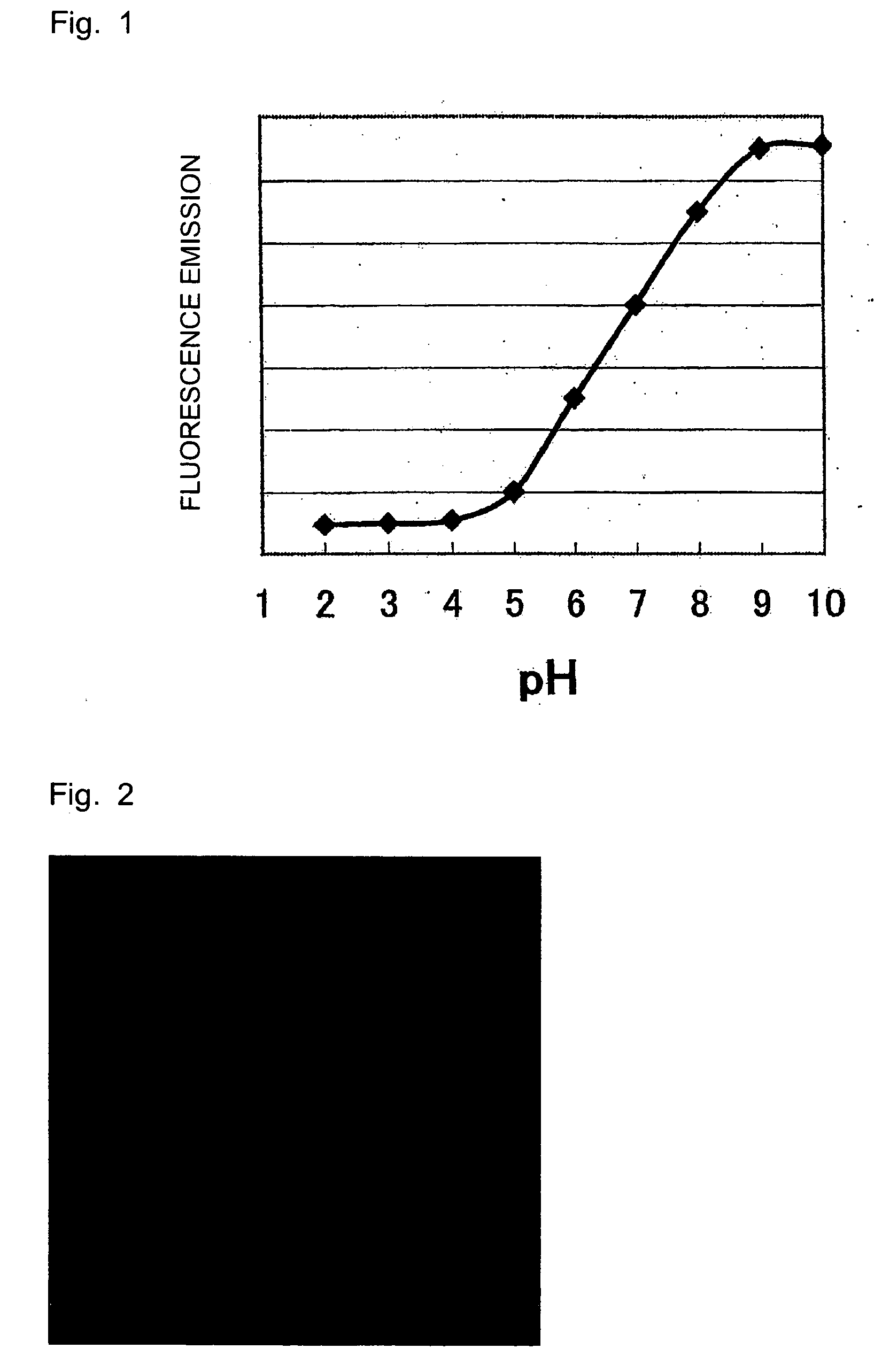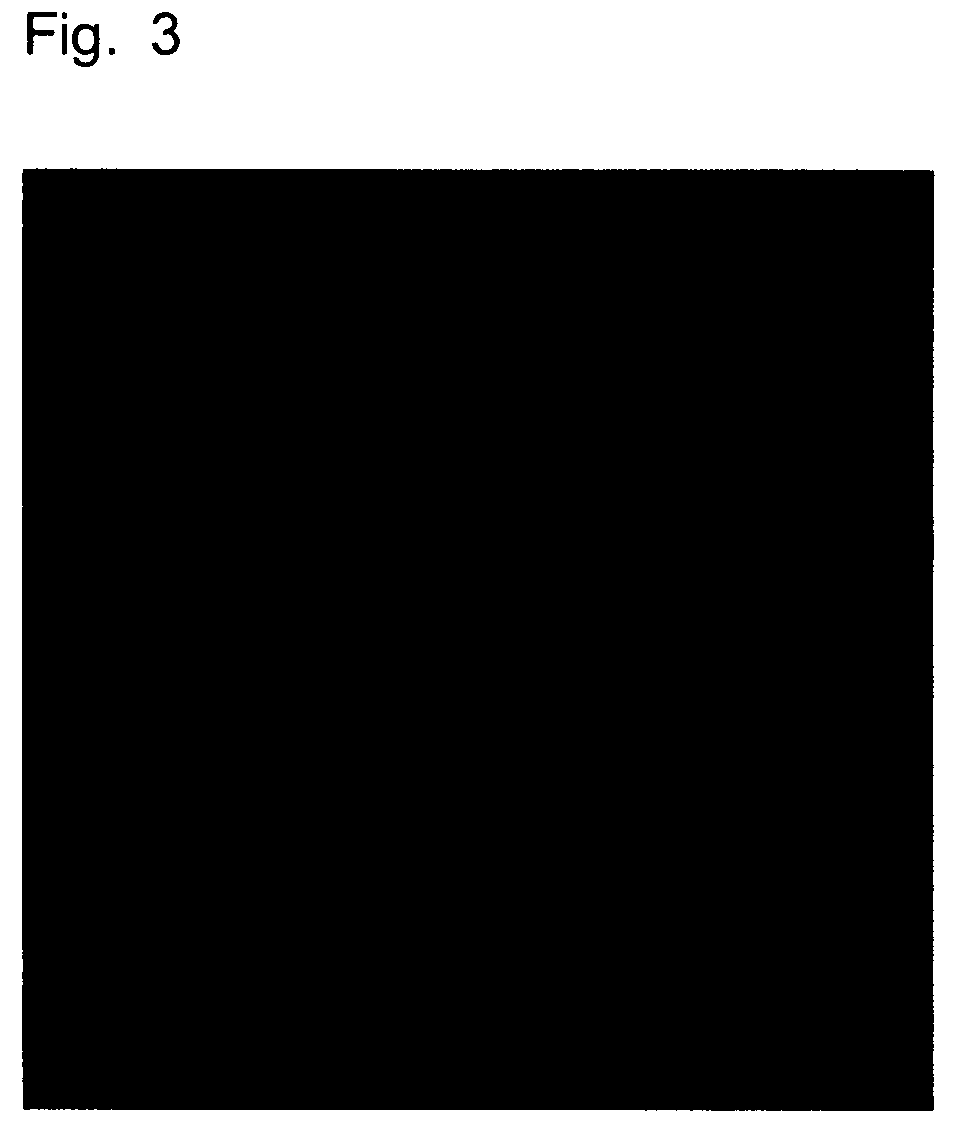Method for fluorescently staining tissue
a fluorescent staining and tissue technology, applied in the field of fluorescent staining tissue, can solve the problems of sample having a different state from that within the living body, sample surface being quite delicate, decoloration of dye from stained tissue, etc., and achieves enhanced fluorescent properties, clear and accurate stained images, and high ph dependence
- Summary
- Abstract
- Description
- Claims
- Application Information
AI Technical Summary
Benefits of technology
Problems solved by technology
Method used
Image
Examples
example 1
[0031]pH-Dependent Fluorescence Emission of Fluorescein
[0032]The pH of an aqueous solution of fluorescein sodium (1 mg / mL) was adjusted with 0.1 M sodium phosphate buffer solution, followed by measurement at an excitation wavelength of 490 nm and a fluorescence wavelength of 530 nm.
[0033]A microplate reader (manufactured by Corona, MTP-800AFC) was used in the fluorescent measurement.
[0034]As seen from the result shown in FIG. 1, the fluorescence intensity of fluorescein gets stronger at higher pH values.
example 2
[0035]Fluorescein Sodium Staining Test on Rat Large Intestine
[0036]The formalin-fixed large intestines of rats (8-week-old, male) were used to observe a difference in staining property against pH. The large intestines were washed for 10 seconds with a phosphate buffered saline (137 mmol / L NaCl, 8.1 mmol / L Na2HPO4, 2.7 mmol / L KCl, 1.57 mmol / L KH2PO4, hereinafter referred to as PBS (−)) and then immersed into solutions of fluorescein sodium (manufactured by Sigma, F6377, hereinafter referred to as F—Na) adjusted and diluted to 1 mg / mL with acidic, alkaline, and neutral buffer solutions. The neutral, alkaline, and acidic buffer solutions used were 0.1 M sodium phosphate buffer solution (pH 7.0), 0.1 M borate buffer solution (pH 9.1), and 0.4 M NaH2PO4 buffer solution (pH 4.65), respectively. After further washing for 10 seconds with PBS (−), the resulting large intestines were fixed with 10% formalin-acid buffer solution and observed with a confocal scanning microscope (manufactured by...
example 3
[0038]Difference in Permeation and Fluorescent Property of Dye Depending on Changes in Solvent pH
[0039]The large intestines of rats (8-week-old, male) were extracted and subjected to a staining test.
[0040]F—Na (manufactured by Sigma, F6377) was adjusted to 1 mg / mL and diluted with 0.1 M sodium phosphate buffer solution (pH 7.0), 0.1 M borate buffer solution (pH 9.1), and 0.4 M NaH2PO4 buffer solution (pH 4.65) to prepare their respective 0.1 mg / mL solutions, into which the tissues were then immersed for 1 minute. After further washing for 10 seconds with PBS (−), the resulting tissues were observed with a confocal scanning microscope (manufactured by Leica Microsystems, TCS-SP2). The results are shown in Table 1.
TABLE 1Fluorescence intensityexamined visually(indicated in five tiers)FreeFluoresceinState of observedfluoresceinin internalimage (clarityinregion ofof fluorescentSolventpHliquid pooltissueimage)0.4 M NaH2PO44.6513Clearsolution0.1 M Na7.053Not clear butphosphatetissue isbuf...
PUM
 Login to View More
Login to View More Abstract
Description
Claims
Application Information
 Login to View More
Login to View More - R&D
- Intellectual Property
- Life Sciences
- Materials
- Tech Scout
- Unparalleled Data Quality
- Higher Quality Content
- 60% Fewer Hallucinations
Browse by: Latest US Patents, China's latest patents, Technical Efficacy Thesaurus, Application Domain, Technology Topic, Popular Technical Reports.
© 2025 PatSnap. All rights reserved.Legal|Privacy policy|Modern Slavery Act Transparency Statement|Sitemap|About US| Contact US: help@patsnap.com


